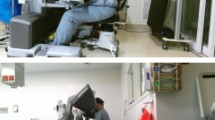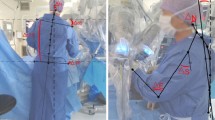Abstract
Purpose
We designed an Artificial X-ray Imaging System (AXIS) that generates simulated fluoroscopic X-ray images on the fly and assessed its utility in improving C-arm positioning performance by C-arm users with little or no C-arm experience.
Methods
The AXIS system was comprised of an optical tracking system to monitor C-arm movement, a manikin, a reference CT volume registered to the manikin, and a Digitally Reconstructed Radiograph algorithm to generate live simulated fluoroscopic images. A user study was conducted with 30 participants who had little or no C-arm experience. Each participant carried out four tasks using a real C-arm: an introduction session, an AXIS-guided set of pelvic imaging tasks, a non-AXIS guided set of pelvic imaging tasks, and a questionnaire. For each imaging task, the participant replicated a set of three target X-ray images by taking real radiographs of a manikin with a C-arm. The number of X-rays required, task time, and C-arm positioning accuracy were recorded.
Results
We found a significant 53% decrease in the number of X-rays used and a moderate 10–26% improvement in lateral C-arm axis positioning accuracy without requiring more time to complete the tasks when the participants were guided by artificial X-rays. The questionnaires showed that the participants felt significantly more confident in their C-arm positioning ability when they were guided by AXIS. They rated the usefulness of AXIS as very good to excellent, and the realism and accuracy of AXIS as good to very good.
Conclusion
Novice users working with a C-arm machine supplemented with the ability to generate simulated X-ray images could successfully accomplish positioning tasks in a simulated surgical setting using markedly fewer X-ray images than when unassisted. In future work, we plan to determine whether such a system can produce similar results in the live operating room without lengthening surgical procedures.








Similar content being viewed by others
References
Pally E, Kreder H (2013) Survey of terminology used for the intraoperative direction of C-arm fluoroscopy. Can J Surg 56(2):109–112
Booij L (2006) Conflicts in the operating theatre. Curr Opin Anesthesiol 20:152–156
Yeo C, Gordon R, Nusem I (2014) Improving operating theatre communication between the orthopaedics surgeon and radiographer. ANZ J Surg 84(5):316–319
Matityahu A, Duffy R, Goldhahn S, Joeris A, Richter P, Gebhard F (2017) The great unknown-a systematic literature review about risk associated with intraoperative imaging during orthopaedic surgeries. Injury 48(8):1727–1734
Matthews F, Hoigne D, Weiser M, Wanner G, Regazzoni P, Suhm N, Messmer P (2007) Navigating the fluoroscope’s C-arm back into position: an accurate and practicable solution to cut radiation and optimize intraoperative workflow. J Orthop Trauma 21(10):687–692
Bott O, Wagner M, Duwenkamp C, Hellrung N, Dresing K (2009) Improving education on C-arm operation and radiation protection with a computer-based training and simulation system. Int J Comput Assist Radiol Surg 4:399–407
Bott O, Dresing K, Wagner M, Raab B, Teistler M (2011) Use of a C-arm fluoroscopy simulator to support training in intraoperative radiography. Radiogr Radiol Soc N Am 31:65–76
Bott O, Teistler M, Duwenkamp C, Wagner M, Marschollek M, Plischke M, Raab B, Stürmer K, Pretschner D, Dresing K (2008) virtX: evaluation of a computer-based training system for mobile C-arm systems in trauma and orthopaedics. Methods Inf Med 47:270–278
Müller M, Belei P, de la Fuente M, Strake M, Weber O, Burger C, Radermacher K, Wirtz D (2011) Evaluation of a fluoroscopy-based navigation system enabling a virtual radiation-free preview of X-ray images for placement of cannulated hip screws: a cadaver study. Comput Aided Surg 16(1):13–22
Wang L, Weidert S (2010) First animal cadaver study for interlocking of intramedullary nails under camera augmented mobile C-arm. A surgical workflow based preclinical evaluation. Proc IPCAI Lect Notes Comput Sci 6135:56–66
Müller M, Kabir K, Gravius S, de la Fuente M, Belei P, Strake M, Wirtz D (2012) Fluoroscopy-based computer-assisted navigation for implant placement and hip resurfacing arthroplasty in the proximal femur: the zero-dose C-arm navigation approach. Biomed Eng 57:209–219
De la Fuente M, Belei P, Ohnsorge J, Skwara A, Radermacher K (2007) Zero-dose C-arm navigation: an efficient approach based on virtual X-ray targeting. Int J Comput Assist Radiol Surg 2(1):256–272
Reaungamornrat S, Otake Y, Uneri A, Schafer S, Mirota D, Nithiananthan S, Stayman J, Kleinszig G, Khanna A, Taylor R, Siewerdsen J (2012) An on-board surgical tracking and video augmentation system for C-arm image guidance. Int J Comput Assist Radiol Surg 7:647–665
De Silva T, Punnoose J, Uneri A, Goerres J, Jacobson M, Ketcha M, Manbachi A, Vogt S, Kleinszig G, Khanna A, Wolinksy J, Osgood G, Siewerdsen J (2017) C-arm positioning using virtual fluoroscopy for image-guided surgery. Proc SPIE Int Soc Opt Eng 10135:101352
Dressel P, Wang L, Kutter O, Traub J, Heining S, Navab N (2010) Intraoperative positioning of mobile c-arms using artificial fluoroscopy. Proc SPIE 7625:762506
Gong R, Jenkins B, Sze R, Yaniv Z (2014) A cost effective and high fidelity fluoroscopy simulator using the image-guided surgery toolkit (IGSTK). Proc SPIE 9036:903618
Chen X, Wang L, Fallavollita P, Navab N (2013) Precise X-ray and video overlay for augmented reality fluoroscopy. Int J Comput Assist Radiol Surg 8:29–38
Cleary K, Ibanez L, Ranjan S, Blake B (2004) IGSTK: a software toolkit for image-guided surgery applications. Int Congr Ser 1268:473–479
De Silva T, Punnoose J, Uneri A, Mahesh M, Goerres J, Jacobson M, Ketcha M, Manbachi A, Vogt S, Kleinszig G, Khanna A, Wolinksy J, Siewerdsen J, Osgood G (2018) Virtual fluoroscopy for intraoperative C-arm positioning and radiation dose reduction. J Med Imaging 5(1):015005
Unberath M, Fotouhi J, Hajek J, Maier A, Osgood G, Taylor R, Armand M, Navab N (2018) Augmented reality-based feedback for technician-in-the-loop C-arm repositioning. Healthc Technol Lett 5(5):143–147
Siddon R (1985) Fast calculation of the exact radiological path for a three-dimensional CT array. Med Phys 12(2):252–255
Bates P, Starr A, Reinert C (2011) The percutaneous treatment of pelvic and acetabular fractures. Orthop Clin N Am 42(1):55–67
Giordano B, Grauer J, Miller C, Morgan T, Rechtine G (2011) Radiation exposure issues in orthopaedics. J Bone Jt Surg 93(69):1–10
Bindal R, Glaze S, Ognoskie M, Tunner V, Malone R, Ghosh S (2008) Surgeon and patient radiation exposure in minimally invasive transforaminal lumbar interbody fusion. J Neurosurg Spine 9:570–573
Han G, Liang Z, You J (2000) A fast ray-tracing technique for TCT and ECT studies. IEEE Nucl Sci Symp 3:1515–1518
Jacobs F, Sundermann E, Sutter B, Christiaens M, Lemahieu I (1998) A fast algorithm to calculate the exact radiological path through a pixel or voxel space. J Comput Inf Tech 6(1):1–12
Newell R, Esfandiari H, Anglin C, Bernard R, Street J, Hodgson A (2018) An intraoperative fluoroscopic method to accurately measure the post-implantation position of pedicle screws. Int J Comput Assist Radiol Surg 13(8):1257–1267
Stefan P, Habert S, Winkler A, Lazarovici M, Fürmetz J, Eck U, Navab N (2018) A radiation-free mixed-reality training environment and assessment concept for C-arm-based surgery. Int J Comput Assist Radiol Surg 13(9):1335–1344
Amiri S, Wilson D, Masri B, Anglin C (2014) A low-cost tracked C-arm (TC-arm) upgrade system for versatile quantitative intraoperative imaging. Int J Comput Assist Radiol Surg 9(4):695–711
Haliburton L, Esfandiari H, Guy P, Anglin C, Hodgson A (2020) A visual odometry base-tracking system for intraoperative C-arm guidance. Int J Comput Assist Radiol Surg 15:1597–1609
Wang F, Davis T, Vemuri B (2002) Real-time DRR generation using cylindrical harmonics. Med Image Comput Comput Assist Interv 2489:671–678
Spoerk J, Bergmann H, Wanschlitz F, Dong S, Birkfellner W (2007) Fast DRR splat rendering using common consumer graphics hardware. Med Phys 34(11):4302–4308
Unberath M, Zaech J, Lee S, Bier B, Fotouhi J, Armand M, Navab N (2018) DeepDRR: a catalyst for machine learning in fluoroscopy-guided procedures. Med Image Comput Comput Assist Interv 2018:98–106
Acknowledgements
The authors would like to thank the following for their support: Institute for Computing, Information and Cognitive Systems (ICICS), Centre for Hip Health and Mobility (CHHM), Francine Anselmo and Dori Kaplun, British Columbia Institute of Technology (BCIT).
Funding
This work was funded by the Natural Sciences and Engineering Research Council of Canada (NSERC) and by the Canadian Institute of Health Research (CIHR) (Grant #214110)
Author information
Authors and Affiliations
Corresponding author
Ethics declarations
Conflict of interest
The authors declare that they have no conflict of interest related to this study.
Ethical approval
Ethics approval was received from the University of British Columbia Clinical Research Ethics Board (H15-00005) and by the British Columbia Institute of Technology Research Ethics Board (2016-09). All procedures performed in studies involving human participants were in accordance with the ethical standards of the institutional and/or national research committee and with the 1964 Helsinki declaration and its later amendments or comparable ethical standards.
Informed consent
Informed consent was obtained from all individual participants included in the study.
Additional information
Publisher's Note
Springer Nature remains neutral with regard to jurisdictional claims in published maps and institutional affiliations.
Rights and permissions
About this article
Cite this article
Touchette, M., Newell, R., Anglin, C. et al. The effect of artificial X-rays on C-arm positioning performance in a simulated orthopaedic surgical setting. Int J CARS 16, 11–22 (2021). https://doi.org/10.1007/s11548-020-02280-2
Received:
Accepted:
Published:
Issue Date:
DOI: https://doi.org/10.1007/s11548-020-02280-2




